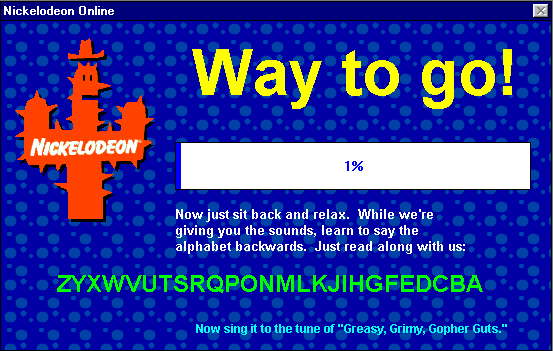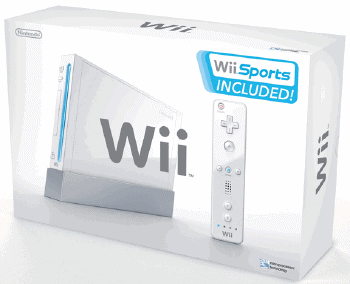For our supply chain class this week, we had two articles about lines and waiting in them. More and more, consumers are looking for an experience, not just a product or service in isolation. Managing customers' wait times is not enough, because they have expectations and perceptions about their wait that need to be managed. As I was reading, I was thinking of some of my own examples, and thought, just in case anyone else finds this interesting, I would post them here. The information in the articles and some of the ideas posted here might be great benchmarks or best practices for anyone starting their own company, too.
- Back in the day
when you had to wait for something to load on your computer for hours,
the Nickelodeon channel on AOL encouraged us to
 learn to say the
alphabet backwards, and then provided the alphabet backwards for us to
practice. It was an idle, somewhat unrelated activity, but I eventually
took their advice and learned the alphabet backwards one day while
waiting for something to load, and can now recite it to this day. Other
ideas would be learning Pi to the 25th digit, memorizing zip codes or
area codes for various parts of the state/country, learning measurement
conversions (I always forget those), or maybe just interesting facts.
These could be used in certain queuing systems with real people just as
much as on the computer.
learn to say the
alphabet backwards, and then provided the alphabet backwards for us to
practice. It was an idle, somewhat unrelated activity, but I eventually
took their advice and learned the alphabet backwards one day while
waiting for something to load, and can now recite it to this day. Other
ideas would be learning Pi to the 25th digit, memorizing zip codes or
area codes for various parts of the state/country, learning measurement
conversions (I always forget those), or maybe just interesting facts.
These could be used in certain queuing systems with real people just as
much as on the computer. - Check out lines can entertain you by the variety of gum, magazines and other various items. By perusing these items in line, you take your mind off, even temporarily, the wait and how long you're waiting and the causes for the wait. There is also the added benefit that the store can gain lots of extra sales from these last-minute impulse buys.
- Massage Envy offers water to their waiting customers - similar to the bar at a restaurant concept - and also suggests that maybe they need to use the restroom before going into their massage appointment. There are also lots of things to buy, from scented candles to therapeutic lotions related to pain relief - similar to check out lines.
 Portillo's Hot Dogs would send employees
outside to the drive-thru lane on a busy day to take orders from people
before their cars physically reached the speaker. Even before they came
to me, I felt better about seeing him/her out there for several
reasons. First, I could see progress, even though my car was barely
moving, he/she was speedily coming down the line. Second, seeing
his/her progress allowed me to predict when he/she would reach my car
(eliminating uncertain waits). Third, once I gave my order, I was in
process and no longer pre-process - this also creates commitment where
some people might bail after waiting so long.
Portillo's Hot Dogs would send employees
outside to the drive-thru lane on a busy day to take orders from people
before their cars physically reached the speaker. Even before they came
to me, I felt better about seeing him/her out there for several
reasons. First, I could see progress, even though my car was barely
moving, he/she was speedily coming down the line. Second, seeing
his/her progress allowed me to predict when he/she would reach my car
(eliminating uncertain waits). Third, once I gave my order, I was in
process and no longer pre-process - this also creates commitment where
some people might bail after waiting so long.- Oregano's has you put your name in like most restaurants, and gives you the option of sitting at the bar like many restaurants. In addition, however, there is plenty of seating provided for the waiting area, and they sometimes walk around with sample pieces of pizza for their waiting customers to try. I love this for lots of reasons, partly just because it helps pass the time, but its also like free advertising for their new pizzas or to get people to try something they wouldn't otherwise.
- Like Oregano's, samples are key to keeping customer satisfaction up at Beyond Bread in Tucson. The sample bread is placed somewhere between the door and the cashiers, depending on how long the ordering line is. If its long, the samples will be available near the door so you can start munching while in line. If the line is short or nonexistent, many customers order first and then grab a piece of bread to munch on while they wait for their food. Drinks are also an important way many restaurants keep you entertained and happy while waiting on food - especially when you get your drink from the fountain yourself… this fills the time up so your idle wait time is shorter.
 Waiting for
the first ever Nintendo Wii's at Walmart - not only was this a
community feeling because we were in line for several hours (Paul and I
got there at 6 for a midnight release), but the store handled it really
well by periodically coming out and letting us know how many Wii's were
available and that only one Wii was allowed per person, so it lowered
our anxiety about getting one. Of course, there were obnoxious, naive
passersby who killed the mood by shouting to us that Wii's would be
widely available by the end of the month - little did they know it would
take years for Nintendo to catch up to demand. Around 11 pm (an hour
before they could sell us the Wii's), the store manager came out and
handed us each a numbered ticket. Without this ticket, nobody would be
able to buy a Wii. So then we had a guarantee to a Wii, and were then
allowed to get dinner or browse the store for an hour. Furthermore, we
retained our place in line with the number, so the first people in line
were the first to receive and pay for their Wii. An added service was
that security guards escorted every customer out of the store and to
their cars just in case someone tried to steal the precious systems from
us.
Waiting for
the first ever Nintendo Wii's at Walmart - not only was this a
community feeling because we were in line for several hours (Paul and I
got there at 6 for a midnight release), but the store handled it really
well by periodically coming out and letting us know how many Wii's were
available and that only one Wii was allowed per person, so it lowered
our anxiety about getting one. Of course, there were obnoxious, naive
passersby who killed the mood by shouting to us that Wii's would be
widely available by the end of the month - little did they know it would
take years for Nintendo to catch up to demand. Around 11 pm (an hour
before they could sell us the Wii's), the store manager came out and
handed us each a numbered ticket. Without this ticket, nobody would be
able to buy a Wii. So then we had a guarantee to a Wii, and were then
allowed to get dinner or browse the store for an hour. Furthermore, we
retained our place in line with the number, so the first people in line
were the first to receive and pay for their Wii. An added service was
that security guards escorted every customer out of the store and to
their cars just in case someone tried to steal the precious systems from
us. - Fry's Electronics - like the Whole Foods in NY we read about, Fry's has a bank-style check out with dozens of cashier stations, red and green lights to denote working or available, and an employee at the front of the line to direct customers to the next available check out.
- Emissions Testing - they have a website to show you a visual video feed of the cars in line as well as the most current prediction of time spent waiting. At the center itself, they also show you the prediction of time spent waiting. This made the wait more bearable - until I saw the average time increasing by one minute every minute. There were also signs to read to prepare you for the test - this also sped up the process I imagine - but it also gave me something to do and decreased anxiety of whether or not I had everything I needed. One addition I would recommend: add that they take cash or credit card and how much the test would be so people can be prepared for this (I had anxiety about it going in). An even better addition would be the take a number approach. You could take a number with an anticipated time to return, and then go grab dinner, etc., instead of waiting in line. Alternatively, there could be two lines, one to wait in and one to take a number in. That would be slick! BTW if anyone is looking for a supply chain project, I think this would be awesome!

No comments:
Post a Comment